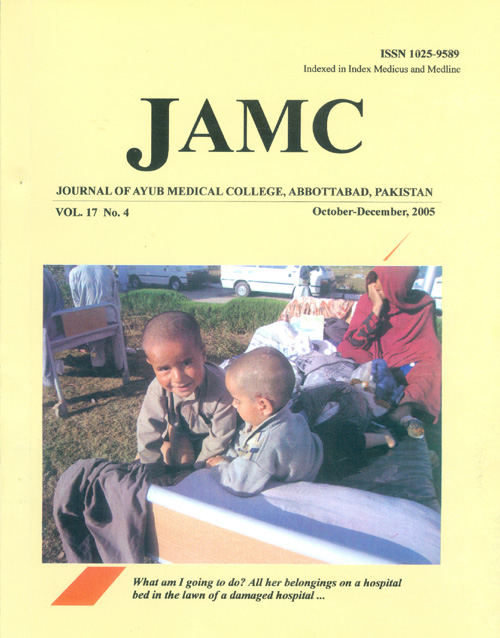DERMATOPHYTE GROWTH AND DEGRADATION OF HUMAN STRATUM CORNEUM IN VITRO (PATHOGENESIS OF DERMATOPHYTOSIS).
Abstract
Background: This study was carried out to determine growth of dermatophytes using humanstratum corneum in vitro and the degrading effect of Keratinases (Proteinases) on stratum corneumfor a complete understanding of the host parasite relationship. Method: Trichophyton rubrumisolates derived from patients with tinea cruris infections were obtained from the Department ofMedical Microbiology, University Hospital of Wales, U.K. Human stratum corneum sterilizedwith ethylene oxide was used as a nitrogen source in agar culture medium plates. Result: Fungalgrowth took place in plates which contained human stratum corneum particles while there was nogrowth in the plates without stratum corneum at three weeks after initiation. There was a gradualdisappearance of the particles of stratum corneum from the plates at the end of the third weekConclusion: The growth of organisms in plates with human stratum corneum and theirdisappearance at third week suggested that stratum corneum was not only source of nutrition forthe dermatophytes, but also the growing fungal mycelia and the proteinases induced by them wereplaying a part in the digestion of granules and thus may have an important role in the pathogenesisof dermatophyte infections.Key-words: Proteinases, Stratum -corneum, DermatophytesReferences
Hay RJ, Brostoff J. Immune responses in patients with
chronic Trichophyton rubrum infections. Clin Exp Dermatol
;2:373-80
Baxter M, Mann PR. Electron microscopic studies of the
invasion of human hair in vitro by three keratinophilic fungi.
Sabouraudia 1969;7:33-7.
Raubitschek F. Mechanical versus chemical keratolysis by
dermatophytes. Sabouraudia 1961;1: 87-91.
Raubitschek F, Maoz R. Invasion of nails in vitro by certain
dermatophytes. J Invest Dermatol 1957;28: 261-7.
Page RM. Observations on keratin digestion by Microsporum
gypseum. Mycologia 1950;42:591-6026. Kunert J. The digestion of human hair by the dermatophyte
Microsporum gypseum in a submerged culture. Mykosen
;15:59-71.
Samdani AJ, Dykes PJ, Marks R. The proteolytic activity of
strains of T. mentagrophytes and T. rubrum isolated from tinea
pedis and tinea unguium infections. J Med & Veter Mycol
;33:167-70.
Tsuboi R, Ko IJ, Matusda K, Ogawa H. A new keratinolytic
proteinase from clinical isolates of Trichophyton
mentagrophytes. J Dermatol 1987; 14: 506-8.
Tsuboi R, Ko IJ, Takamori K, Ogawa H. Isolation of a
keratinolytic proteinas from Trichophyton mentagrophytes
with enzymatic activity at acidic pH. Infect Immun 1989;57:
-83.
English MP. The saprophytic growth of keratinophilic fungi
on keratin. Sabouraudia 1963;2:115-30.
Kushwaha RKS. The in vitro degradation of peacock feathers
by some fungi. Mykosen 26:324-6.
Wawrzkiewicz K, Lobarzewski J, Wolski T. Intracellular
keratinase of Trichophyton gallinae. J Med Vet Mycol 1987;
: 261-8.
Issue
Section
License
Journal of Ayub Medical College, Abbottabad is an OPEN ACCESS JOURNAL which means that all content is FREELY available without charge to all users whether registered with the journal or not. The work published by J Ayub Med Coll Abbottabad is licensed and distributed under the creative commons License CC BY ND Attribution-NoDerivs. Material printed in this journal is OPEN to access, and are FREE for use in academic and research work with proper citation. J Ayub Med Coll Abbottabad accepts only original material for publication with the understanding that except for abstracts, no part of the data has been published or will be submitted for publication elsewhere before appearing in J Ayub Med Coll Abbottabad. The Editorial Board of J Ayub Med Coll Abbottabad makes every effort to ensure the accuracy and authenticity of material printed in J Ayub Med Coll Abbottabad. However, conclusions and statements expressed are views of the authors and do not reflect the opinion/policy of J Ayub Med Coll Abbottabad or the Editorial Board.
USERS are allowed to read, download, copy, distribute, print, search, or link to the full texts of the articles, or use them for any other lawful purpose, without asking prior permission from the publisher or the author. This is in accordance with the BOAI definition of open access.
AUTHORS retain the rights of free downloading/unlimited e-print of full text and sharing/disseminating the article without any restriction, by any means including twitter, scholarly collaboration networks such as ResearchGate, Academia.eu, and social media sites such as Twitter, LinkedIn, Google Scholar and any other professional or academic networking site.









